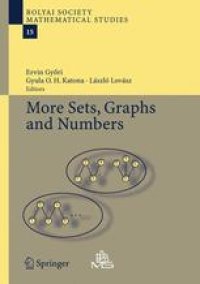
Ebook: More Sets, Graphs and Numbers: A Salute to Vera Sós and András Hajnal
- Tags: Combinatorics, Mathematical Logic and Foundations, Number Theory
- Series: Bolyai Society Mathematical Studies 15
- Year: 2006
- Publisher: Springer-Verlag Berlin Heidelberg
- Edition: 1
- Language: English
- pdf
Discrete mathematics, including (combinatorial) number theory and set theory has always been a stronghold of Hungarian mathematics. The present volume honouring Vera Sos and Andras Hajnal contains survey articles (with classical theorems and state-of-the-art results) and cutting edge expository research papers with new theorems and proofs in the area of the classical Hungarian subjects, like extremal combinatorics, colorings, combinatorial number theory, etc. The open problems and the latest results in the papers inspire further research.
The volume is recommended to experienced specialists as well as to young researchers and students.
Discrete mathematics, including combinatorial number theory and set theory, has always been a stronghold of Hungarian mathematics. This volume honours the eminent mathematicians Vera Sos and Andras Hajnal. The book includes survey articles reviewing classical theorems, as well as new, state-of-the-art results. Also presented are cutting edge expository research papers with new theorems and proofs in the area of the classical Hungarian subjects, like extremal combinatorics, colorings, combinatorial number theory, etc. The open problems and the latest results in the papers are sure to inspire further research.
This book is recommended for experienced specialists as well as to young researchers and students.
Discrete mathematics, including combinatorial number theory and set theory, has always been a stronghold of Hungarian mathematics. This volume honours the eminent mathematicians Vera Sos and Andras Hajnal. The book includes survey articles reviewing classical theorems, as well as new, state-of-the-art results. Also presented are cutting edge expository research papers with new theorems and proofs in the area of the classical Hungarian subjects, like extremal combinatorics, colorings, combinatorial number theory, etc. The open problems and the latest results in the papers are sure to inspire further research.
This book is recommended for experienced specialists as well as to young researchers and students.
Content:
Front Matter....Pages 1-8
A Unifying Generalization of Sperner’s Theorem....Pages 9-24
A Quick Proof of Sprindzhuk’s Decomposition Theorem....Pages 25-32
Discrepancy in Graphs and Hypergraphs....Pages 33-56
Biplanar Crossing Numbers I: A Survey of Results and Problems....Pages 57-77
An Exercise on the Average Number of Real Zeros of Random Real Polynomials....Pages 79-92
Edge-Connection of Graphs, Digraphs, and Hypergraphs....Pages 93-141
Perfect Powers in Products with Consecutive Terms from Arithmetic Progressions....Pages 143-155
The Topological Version of Fodor’s Theorem....Pages 157-174
Color-Critical Graphs and Hypergraphs with Few Edges: A Survey....Pages 175-197
Pseudo-random Graphs....Pages 199-262
Bounds and Extrema for Classes of Graphs and Finite Structures....Pages 263-283
Relaxing Planarity for Topological Graphs....Pages 285-300
Notes on CNS Polynomials and Integral Interpolation....Pages 301-315
The Evolution of an Idea — Gallai’s Algorithm....Pages 317-328
On the Number of Additive Representations of Integers....Pages 329-339
A Lifting Theorem on Forcing LCS Spaces....Pages 341-358
Extremal Functions for Graph Minors....Pages 359-380
Periodicity and Almost-Periodicity....Pages 381-405
Discrete mathematics, including combinatorial number theory and set theory, has always been a stronghold of Hungarian mathematics. This volume honours the eminent mathematicians Vera Sos and Andras Hajnal. The book includes survey articles reviewing classical theorems, as well as new, state-of-the-art results. Also presented are cutting edge expository research papers with new theorems and proofs in the area of the classical Hungarian subjects, like extremal combinatorics, colorings, combinatorial number theory, etc. The open problems and the latest results in the papers are sure to inspire further research.
This book is recommended for experienced specialists as well as to young researchers and students.
Content:
Front Matter....Pages 1-8
A Unifying Generalization of Sperner’s Theorem....Pages 9-24
A Quick Proof of Sprindzhuk’s Decomposition Theorem....Pages 25-32
Discrepancy in Graphs and Hypergraphs....Pages 33-56
Biplanar Crossing Numbers I: A Survey of Results and Problems....Pages 57-77
An Exercise on the Average Number of Real Zeros of Random Real Polynomials....Pages 79-92
Edge-Connection of Graphs, Digraphs, and Hypergraphs....Pages 93-141
Perfect Powers in Products with Consecutive Terms from Arithmetic Progressions....Pages 143-155
The Topological Version of Fodor’s Theorem....Pages 157-174
Color-Critical Graphs and Hypergraphs with Few Edges: A Survey....Pages 175-197
Pseudo-random Graphs....Pages 199-262
Bounds and Extrema for Classes of Graphs and Finite Structures....Pages 263-283
Relaxing Planarity for Topological Graphs....Pages 285-300
Notes on CNS Polynomials and Integral Interpolation....Pages 301-315
The Evolution of an Idea — Gallai’s Algorithm....Pages 317-328
On the Number of Additive Representations of Integers....Pages 329-339
A Lifting Theorem on Forcing LCS Spaces....Pages 341-358
Extremal Functions for Graph Minors....Pages 359-380
Periodicity and Almost-Periodicity....Pages 381-405
....